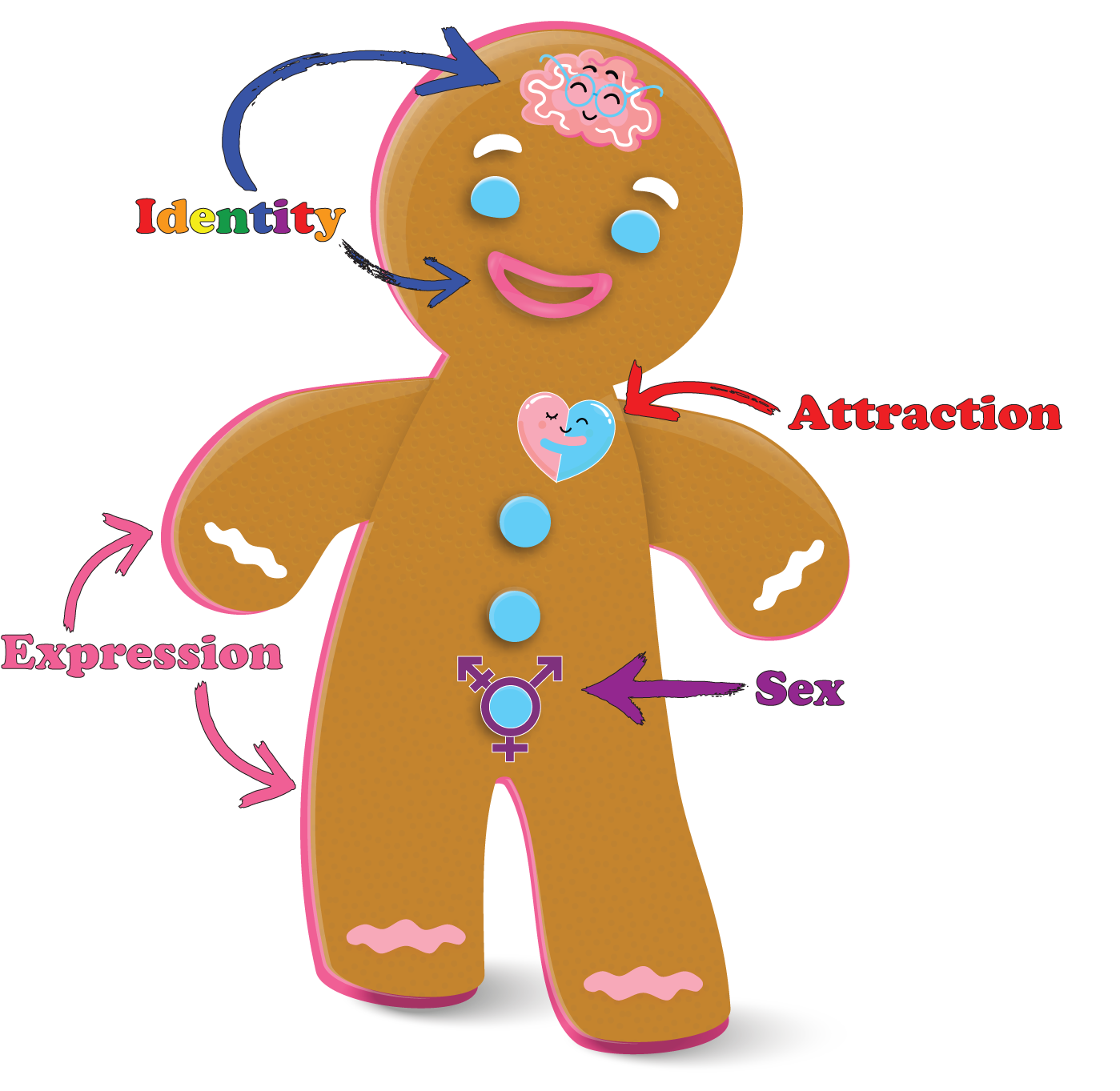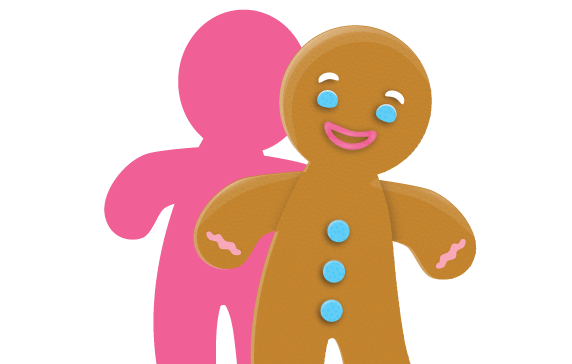
Understanding Gender
Identity ≠ Expression ≠ Sex ≠ Gender ≠ Sexual Orientation
Genderbread Person
Making Gingerbread cookies seems like an easy process; you first gather the supplies, mix your liquids, and then combine them with your dry ingredients. Put them in the oven and decorate when cool. Most people understand the basic steps to baking cookies, but would be lost without a recipe to help break down the steps into bit sized pieces.
Much like the basic steps to baking cookies, most people think they understand gender as an overall concept, but when we break it down, we see that gender is often misunderstood. After all, gender is not binary. It is not either/or, it’s both/and. Gender is a bit of this and a dash of that.
When creating a Genderbread person, we switch out the eggs, flour, sugar and molasses for identity, expression, attraction, and sex (1). Blended together, these four main ingredients create a tasty little introduction to understanding gender.
Baking a Genderbread Person: Ingredients
Personality traits, roles, and expectations.
AN OUNCE OF IDENTITY: Gender identity is your internal sense of self that can be thought of as how “manly” or “womanly” you either do or don’t align with. In this case, we are talking about societal norms (social expectations), and roles (ways we fulfill or act out those expectations) placed upon cis-men and cis-women. Some folks identify with neither “man-ness” or “woman-ness,” but a third gender altogether. Some folks identify with aspects of both, and might use the label “genderqueer” to describe their identity.
Use proper pronouns for respectful communication.
He/Him/His - She/Her/Hers - They/Them/Theirs - Ze/Hir/Hirs
None (use preferred name)
Pronouns “he” and “she” come with a certain set of expectations about how someone should express their identity and relate to the world. Conventional pronouns have the effect of assigning them a binary identity ("he/she").
A gender neutral or gender inclusive pronoun is a pronoun which does not associate a gender with the individual who is being discussed. Some languages do not have a gender neutral or third gender term and only have binaries (“he”/”she”).
Some people have a gender identity that is non-binary. Gender-neutral pronouns are words that do not specify whether the person is female or male. 'They', for instance, is a third-person pronoun that is gender neutral. Other gender-neutral pronouns include 'them', 'this person', 'everyone', 'Ze', or 'Hir'. Everyone has the right to self-identify with whatever pronoun they feel comfortable (or, to avoid identifying altogether).
Style, grooming, clothing, mannerisms, appearance, hair, or make-up.
A CUP OF EXPRESSION: Gender expression can be thought of as the aspects of masculinity and femininity you display in your clothing, grooming, speech, actions, demeanor, and more. As examples, masculine dress might be considered baggy clothing or functional attire. Feminine dress is form-fitting, colourful, and frivolous. The term “androgynous” is used to describe gender expression that is both masculine and feminine; think of a short hair cut womxn in a business suit, for example.
Refers to attraction of a sexual or romantic nature.
A QUART OF ATTRACTION: With sexuality (who you are attracted to you), we often subtly reinforce a different binary, thinking people are “gay or straight.” There are many ways folks identify and experience sexuality, so a helpful way to think about that is to distinguish between our romantic and sexual attraction. Some folks experience both, some experience one more than the other, and some folks experience little to none of either. Many of us experience sexual attraction and romantic attraction at about the same levels, and to the same or opposite genders, and therefore may not feel a big difference between the two. However others, like people who are asexual but who are not aromatic, may experience romantic attraction (wanting to go on dates, have intimate conversations etc.) without experiencing sexual attraction.
Hormones, gonads, and chromosomes.
A SPRINKLE OF SEX: Sex is assigned at birth and can be thought of as the aspects of “male-ness” or “female-ness” you embody in your physical self. Examples of “male-ness” are based on gonads like “penis, testicles” as well as secondary traits (which are developed during puberty” like “coarse body hair, wide shoulders.” Examples of “female-ness” are gonads like “vagina, ovaries” and secondary traits like “breasts, wide hips.”
Some folks are predominantly male or female, while others are intersex. There are multiple reasons and ways that our bodies look the way they do or are the way they are. Cancers or other illnesses, hormone imbalances, or gender affirmation can all play a factor in the type of sexed body that we have. This is not a pathology, but is and should be celebrated as diversity.
Like any good cookie recipe, start by mixing the liquid ingredients above.
After all, gender is fluid.
More resources on this topic:
References:
Killermann, S. “Genderbread Person v4.0” The Genderbread Person 2018. Accessed June 1, 2020 <https://www.genderbread.org>
Genderbread Cookie YouTube Video. Published 2018. Accessed June 1, 2020 <https://www.youtube.com/watch?v=-cdsGFnNp6Q&fbclid=IwAR0NzBlNJCpUICpaZLeDyYuYcus0y_3qA8lKAuZSVdcgTZTeNSy646w2f4c>







